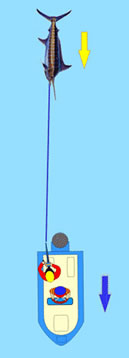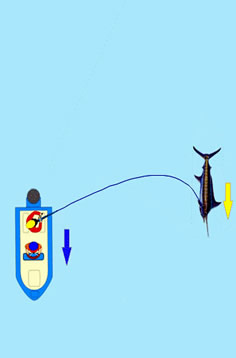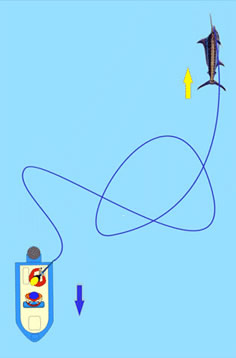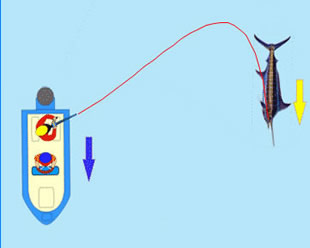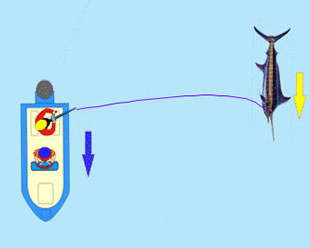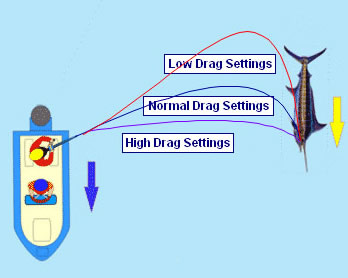05. Fighting Fish: Angler
Between The Lines - Ch: 12 Fighting Fish
|
From the time the angler has pulled the rod out of the holder, he has control of the rod and reel. The angler contribution to the fight can be far more than just keeping the line tight. Just as the boat should not be in neutral throughout the fight, nor should the reel. The line should either be coming off or going onto the spool. If you didn't do the angler exercises earlier, please go back and go through the exercise and practice them so you are ready for what follows. Just as importantly, all the gear should be prepared to a level whereby you can trust the reel, rod, all knots and joins, leaders, hooks etc, as now more than ever you should be in the frame of mind where your only concern is catching that fish: not worried about losing them. You know your gear, you know how it feels at various pressures and now it's time to put it all together. Plus of course, we'll add a bit more information and a couple of concepts and tactics. Don't worry about things that can go wrong, they will - it's all a part of fishing. Before getting into pumping, winding and thrusting, we'd better pause and go through a couple of concepts so the angler's energy and crews' time is not wasted and the fish is not fought to the death in the fight. The correct positioning of the boat throughout the fight is also crucial, maneuvering to aid the angler by maintaining the best overall relative positions of the angler to fish. Tight Line, Straight LineThere are several factors involved with how straight the line is to the fish such as the direction of the fish in relation to the direction of the angler, which in this case is the same direction as the boat. That is up until the fish is close then it can change according to which side of the transom the angler is positioned. The more the two are travelling in the same direction the straighter the line will be. (Fig 1)
If the angler and fish are moving parallel to each other the line will have its greatest belly. (Fig 2) When the fish is arcing, that is not swimming in a straight line, on a run and changing direction, the line will follow the course of the arc and the changes of direction. (Fig 3) The degree of ‘straightness' is a factor of how tight the line is, that is how much drag, how thick the line is, and how fast the fish and boat are travelling in relation to each other. The factors we can control is how much drag we apply, the angle of pull on the fish, and for most of the fight, the distance of the fish from the boat. Angling AnglesThe angle of the line to the fish is used to either tire the angler or tire the fish, certainly, the latter is the preferable choice. Although we are dealing with the relative positioning of the fish to the angler which is three dimensional, we will simplify the system by breaking it up into depth and distance. The deeper the fish the less impact the angler has on it as the pull is coming from above the fish. Most predators have large pectoral fins designed to help the fish glide. As long as the fish can use these, only brute force can lift it with a direct pull from above. The greater the angle to the fish the greater the chance of leading it or getting it back to the surface. In fact getting the fish to use its pectoral fins to raise the fish rather than to dive deeper. The more aligned the fish is to the line the more it can use all its muscles and fins to fight as is the case with low drag settings. (Fig 4) As you change the pull to the side of the fish by increasing drag (Fig 5) thereby not only making the line tighter, but also straighter to the fish, the fewer fins and muscles it can use to combat the effects of the line and drag. In effect, the drag setting controls not only the effective fighting angle but also the amount of belly that is in the line and how direct the pull is on the fish. (Fig 6) Once again the actual angle of the line to the fish depends on how the fish is positioned relative to the boat, the direction the fish is going and how much drag is applied.
By working through the combinations of angles you'll find the optimum is a fish near the surface with the line at a low angle to the surface and also pulling at the side of the fish.
The greatest control of the fish is gained by pulling directly from the side. In fact, when a fish is close you can easily turn or roll it over by having the rod tip level with the fish and sweeping the tip from the front of the fish to the back. (Vid 1) Vid 1 Drag ControlAs the fish runs, as long as it is running away from the boat, then the angler can simply lift the rod out of the holder. Note if the outfit is a heavy tackle outfit or if the angler is small or unfit, the angler may have to back off the drag to enable them to get the rod out of the holder and stay in control. Note here as well, the reel should still have as much drag as the angler can tolerate. The rod should stay upright and loaded through this procedure. Once the angler is either set up in the chair or gimbal and harness, that is, as soon as possible, the drag should be returned to at least ‘strike' i.e. one-third of the breaking strain. As long as the spool is turning, and the rod is loaded - that is, bent under load - then the angler is in reasonable control. If the reel should stop turning - the fish has either stopped running or the boat has caught up with the fish - the angler should retrieve the line as quickly as necessary maintaining the loaded rod. If the fish surges or the boat slows, the angler should allow the fish to pull the rod down to allow the reel a smoother transition from being still to turning. This is to cushion the initial turning of the reel which is in a state of inertia. This procedure is called ‘bowing the rod'. Vid 2 To get slightly more advanced, if the spool is turning, the angler can safely increase the drag setting to around 50 percent of the breaking strain. And to get the adrenalin rushing, go to 70 percent, although this may be reserved for more experienced anglers. As long as the fish is running and the spool is turning or you are retrieving line you can maintain these high drag settings. If the fish begins another run, as you bow the rod, back the drag off once again to a third, and once the spool is turning you can go back up again. The two main points to understand are: Vid 3 The situations where backing the drag off would be advisable is if the fish is small relative to line class, for example, a 60-kilo black marlin on 37-kilo line. A drag setting of 12 kilos would flip the fish backwards in any jump and rip the hooks out of its mouth. A reasonable proportion of drag to fish is a maximum of around 10 percent of the fish's weight. At under a third drag setting, nylon is not stretched to any great extent as one of the characteristics of nylon is it undergoes most of its stretching between 20 and 30 percent. Thus, in effect, using under a third means you are using a rubber band, which makes catching small fish on heavy tackle rather difficult and losses from slackline are high, as these low drag settings mean you are never actually tight to the fish. The more line out, the safer it is to use high drag settings as there will always be a degree of stretch and belly that will cushion the line. As the fish gets closer to the boat, say 50 meters or less, there is far less belly and far less cushioning, so you will have to react quickly, backing the drag off slightly if the fish surges or starts to take the line. The angler should be aware the less line on the spool the higher the drag setting will be and this is certainly a consideration, however, by going through the previous chapters in detail you will have a full understanding of this. The difference between a good angler and a beginner is the smoothness of technique. The smoother the better, while maintaining an even pressure on the fish. This does not mean these motions are slow, in fact, you can become incredibly fast and smooth while maintaining a high drag setting on a fish, this is when you reach the level of ‘master angler'.
|





